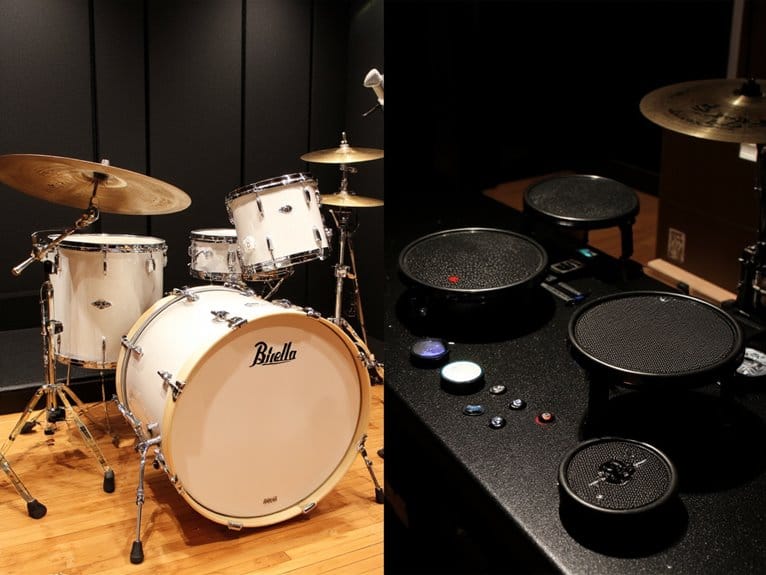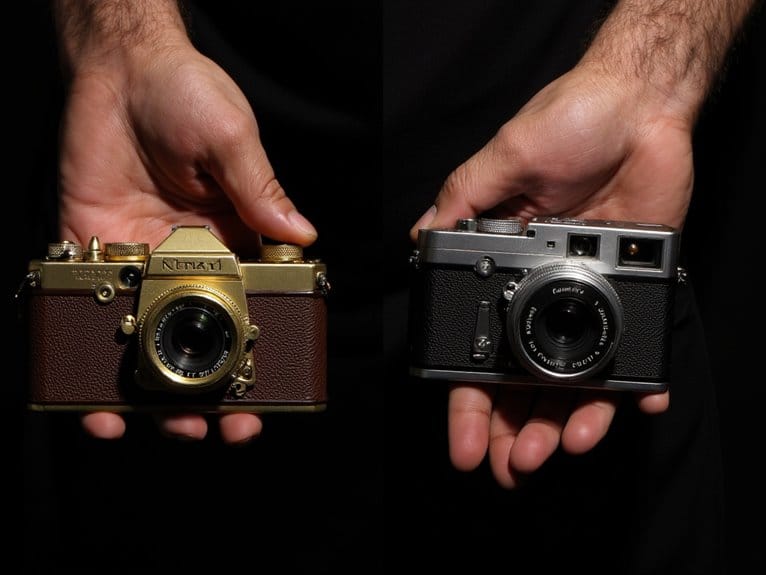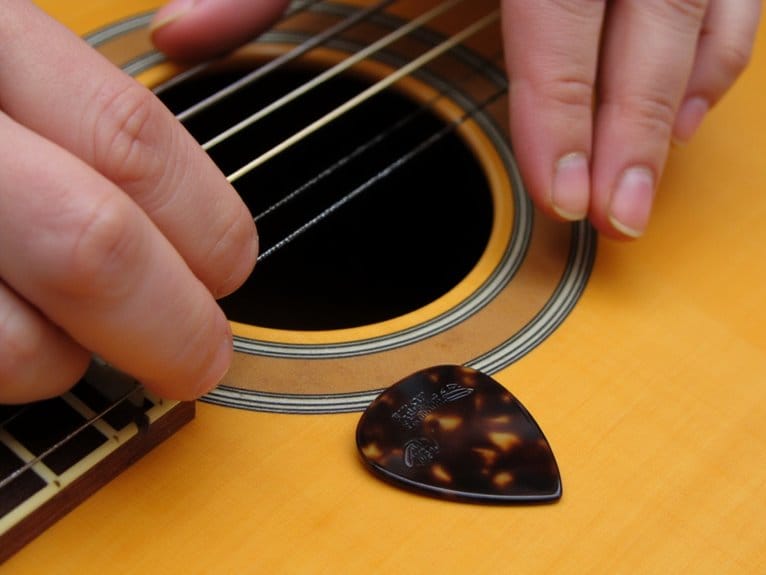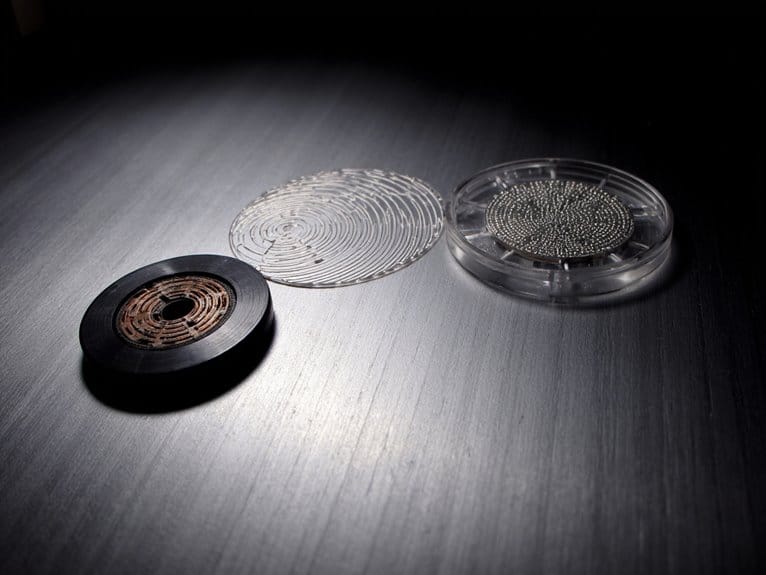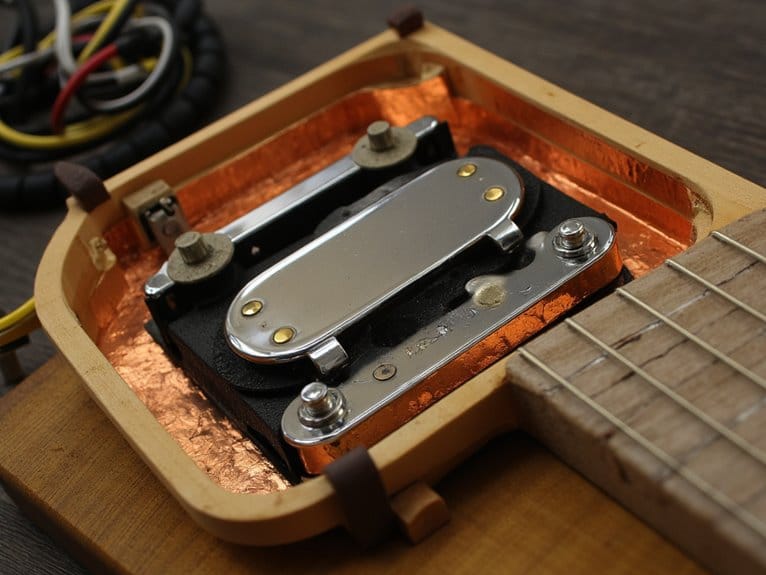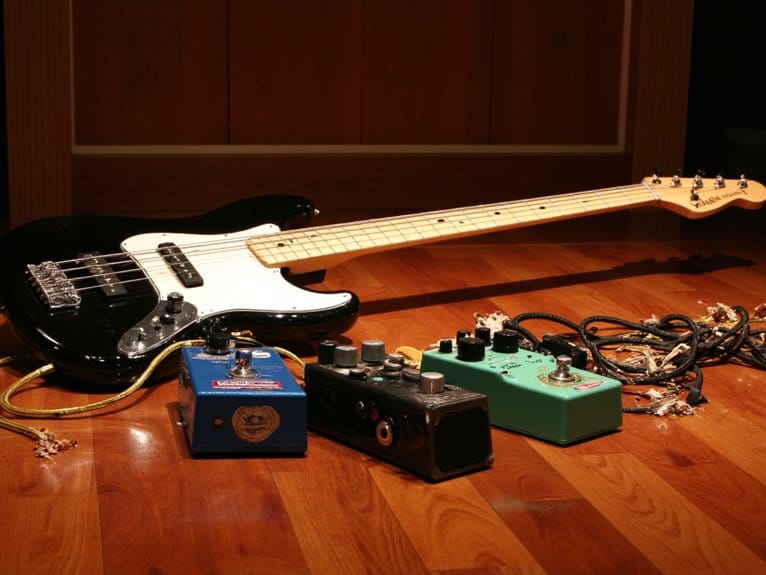Electronic Drums Vs Acoustic: Which Works Best for Home Studios?
For home studios, electronic drums typically outperform acoustic kits in most practical areas, offering precise volume control at 60-75 decibels versus acoustic’s 90-130 decibel range, requiring only 3-7 square feet of space, and providing seamless DAW integration through simple USB connections rather than expensive microphone setups costing $1,500+. While acoustic drums deliver superior tactile response for ghost notes and rapid doubles, electronic kits excel in noise management, creative versatility with instant sound switching, and lower maintenance costs at $20-50 annually compared to acoustic’s $150-300. Understanding these trade-offs will help you optimize your specific studio environment and musical goals.
We are supported by our audience. When you purchase through links on our site, we may earn an affiliate commission, at no extra cost for you. Learn more.
Notable Insights
- Electronic drums offer superior volume control (60-75 dB) compared to acoustic drums (90-130 dB), making them ideal for home studios.
- Electronic kits require 30-40% less space and integrate seamlessly with DAWs via simple USB connections for streamlined recording workflows.
- Recording costs favor electronic drums significantly: $200 USB setup versus $1,500+ microphone systems required for acoustic drum recording.
- Electronic drums provide instant sound switching, built-in effects, and consistent levels without microphone placement complexities or acoustic treatment needs.
- Annual maintenance costs are minimal for electronic drums ($20-50) compared to acoustic drums ($150-300) for ongoing head replacements and hardware upkeep.
Sound Quality and Creative Versatility Comparison
When I first started comparing drums for my home studio, I’ll admit I was skeptical about whether electronic kits could match the raw, organic sound that comes from striking an actual drumhead and hearing those natural vibrations resonate through wood and metal.
After extensive testing, I’ve found that high-end electronic kits achieve impressive sound realism through multi-layered samples and velocity-sensitive triggering, though subtle differences in attack and decay remain noticeable to trained ears. The overall quality depends heavily on the sample libraries included with each kit, as these pre-recorded sounds determine how authentic your drums will sound during playback.
However, electronic drums excel in creative potential, offering instant access to diverse kit configurations, built-in effects processing, and the ability to layer multiple sounds per pad—capabilities that far exceed what you’ll get from fixed acoustic setups in home studio environments. Electronic kits also enable real-time adjustments during recording sessions, allowing you to modify sounds on the fly without stopping your creative flow.
Volume Control and Noise Management Solutions
Sound quality matters, but if you can’t actually play your drums without getting evicted or facing neighborhood complaints, even the most pristine audio becomes irrelevant.
Electronic drums excel at volume dynamics, offering precise control through adjustable knobs that keep your sessions between 60-75 decibels, while acoustic kits blast 90-130 decibels with no mercy.
Electronic drums let you dial down the volume to apartment-friendly levels while acoustic kits pummel your eardrums at concert-hall intensity.
For effective sound isolation in your home studio, consider these solutions:
- Closed-back headphones eliminate noise leakage and protect your hearing during extended practice sessions
- Mesh pads produce considerably less mechanical noise than rubber alternatives or acoustic shells
- Isolation mats placed under your kit reduce floor vibrations that travel through walls
- Noise-eating pedals dampen bass drum impact sounds that typically disturb neighbors below
Electronic drums simply dominate noise management. Professional drum headphones with memory foam cushions provide essential comfort for extended practice sessions while maintaining audio precision. Models with impedance ratings of 63 ohms or higher work well with electronic drum modules while providing the power needed for clear sound reproduction. However, even electronic drums can produce concerning sound levels, with professional measurements showing levels reaching up to 94 dB maximum, which can pose hearing risks with prolonged exposure despite their reputation as a safer alternative.
Space Requirements and Portability Factors
When you’re setting up a home studio, space becomes your most precious commodity. I’ve learned firsthand that choosing between electronic and acoustic drums can make or break your entire room layout.
Electronic kits typically require just 3-7 square feet of floor space, allowing you to squeeze professional drumming capabilities into bedrooms, apartments, or multipurpose rooms where acoustic sets simply won’t fit comfortably.
You’ll find that compact electronic setups integrate seamlessly with your other studio gear, computers, and audio interfaces, while still leaving enough room to move around and actually enjoy playing in your space.
Many budget electronic models feature collapsible frames that fold for easy storage, making them ideal for home studios where you need to quickly reconfigure your space for different recording sessions or daily living.
Compact Setup Advantages
Throughout my years of setting up home studios in cramped apartments and converted bedrooms, I’ve learned that space constraints often become the deciding factor between electronic and acoustic drums, with electronic kits consistently offering a more compact footprint that can transform even the smallest room into a functional recording space.
Electronic drums excel with their compact design and modular setups, delivering remarkable space efficiency:
- Footprint reduction: Electronic kits require 30-40% less floor space than acoustic drums while maintaining full playability.
- Vertical optimization: Drum rack systems stack components efficiently, maximizing limited room height.
- Multipurpose integration: Quiet operation allows placement in living rooms or bedrooms without dedicated isolation.
- Quick reconfiguration: Modular components adapt instantly to changing space needs or equipment additions.
Many electronic drum kits feature lightweight designs that make them ideal for musicians who need to transport their equipment between different recording locations or practice spaces. Similar to portable bass amplifiers, the under 3 pounds weight category has become increasingly popular for musicians prioritizing mobility without sacrificing functionality.
This flexibility proves invaluable when you’re working within tight spatial constraints. Unlike traditional acoustic setups, electronic drums eliminate the need for multiple drum hardware stands that typically consume significant floor space and create complex setup requirements in home studio environments.
Home Studio Integration
Beyond the obvious space-saving benefits, the real game-changer lies in how seamlessly electronic drums integrate into your home studio workflow. This is something I’ve witnessed firsthand after helping dozens of producers optimize their cramped recording setups.
You’ll connect directly via USB or MIDI to your DAW, eliminating the microphone placement headaches and acoustic treatment costs that plague acoustic setups.
Electronic kits excel at drum programming, letting you layer samples and trigger sounds impossible with traditional shells. The sound sampling capabilities mean you’re not limited to one kit’s sonic character—you can switch between vintage Ludwig, modern Tama, or custom samples mid-session.
This integration transforms your bedroom corner into a professional recording environment without the neighbor complaints.
Initial Investment and Ongoing Cost Analysis
When you’re setting up your home studio, the financial commitment extends far beyond that initial price tag.
I’ve learned through years of gear acquisitions that understanding both upfront costs and long-term expenses can save you from budget surprises down the road. You’ll find that entry-level acoustic kits typically start cheaper than their electronic counterparts.
However, the ongoing maintenance costs, replacement drumheads, and potential recording equipment needs can quickly shift that equation in unexpected directions.
The real cost comparison becomes clear when you factor in everything from regular tuning sessions and hardware repairs to the microphones, audio interfaces, and acoustic treatment that each drum type requires for professional home studio results.
Entry-Level Price Comparison
One of the most eye-opening discoveries I’ve made while researching home studio setups is how dramatically the initial investment differs between electronic and acoustic drums.
Entry-level electronic kits start around $460 for models like the Donner DED-200X, while comparable acoustic setups typically begin at $600.
These prices quickly escalate once you factor in essential additions like cymbals, stands, and hardware that aren’t included in the base price.
These price trends reveal some interesting budget tips worth considering:
- Electronic kits like the Alesis Command Mesh ($799) include integrated hardware, eliminating surprise costs.
- Acoustic kits often require additional $200-400 investments for complete functionality.
- Entry-level electronic options offer compact designs perfect for space-limited home studios.
- Both kit types require drumsticks as ongoing consumables, typically $10-20 per pair.
Additionally, electronic drum setups require amplification, with quality drum amplifiers ranging from $200-400 for models like the Donner DA-35 or Alesis Nitro Amp.
Long-Term Maintenance Costs
While that upfront investment sets the stage, I’ve learned through years of studio ownership that the real financial story unfolds in the maintenance costs that accumulate over time, where acoustic drums typically demand $150-300 annually for drum head replacements, cymbal repairs, and hardware upkeep, compared to electronic kits that often coast for years with minimal expenses beyond the occasional cable replacement or pad cleaning.
| Maintenance Aspect | Acoustic Drums | Electronic Drums |
|---|---|---|
| Replacement Frequencies | Drum heads every 3-6 months | Pads every 3-5 years |
| Annual Costs | $150-300 | $20-50 |
Your maintenance schedules become dramatically different between these systems, where acoustic kits demand regular tuning sessions and hardware lubrication, while electronic drums simply require occasional calibration and cleaning—a reality that’s saved me countless hours of tedious upkeep. Many home studio producers also incorporate dedicated beat machines into their electronic setups, which can further extend the lifespan of drum pads by reducing the wear from constant triggering during extended production sessions.
Recording Equipment Expenses
Beyond those ongoing maintenance expenses, I’ve discovered that recording equipment costs create perhaps the most dramatic financial divide between acoustic and electronic drums, where your initial investment can swing from a simple $200 USB cable for electronic kits to a complex $1,500+ microphone setup for acoustic drums.
Electronic drums connect directly to DAWs via USB or MIDI, eliminating expensive recording interfaces and microphone selection headaches.
Acoustic drums demand extensive investment in room preparation:
- Multiple microphones and stands ($400-800)
- Audio interfaces with sufficient preamps ($200-600)
- Acoustic treatment panels for sound control ($300-700)
- Soundproofing options to contain volume ($500-1,200)
While electronic kits offer plug-and-play convenience with built-in sound modules, acoustic setups require deliberate environmental preparation that can easily triple your recording budget before you’ve even hit a single snare. Professional low-latency recording requires audio interfaces with buffer sizes of 64-256 samples and quality preamps to achieve the tight timing essential for drum tracks.
For acoustic recordings, proper microphone placement around each drum and cymbal is essential for optimal recording quality, often requiring multiple sessions to dial in the perfect positioning and sound isolation. Additionally, protecting your recording equipment from environmental factors becomes crucial, as water-resistant cases can prevent costly damage to microphones and interfaces in humid studio conditions.
Playing Feel and Tactile Response Differences
When I first switched from acoustic to electronic drums in my home studio, the most jarring difference wasn’t the sound—it was how everything felt under my sticks.
The real shock wasn’t hearing the difference between acoustic and electronic drums—it was feeling it through every single stick strike.
The tactile feedback between acoustic drumheads and electronic pads creates fundamentally different playing dynamics that you’ll notice immediately. Acoustic drums offer natural rebound characteristics through stretched drumheads, providing organic response textures that vary with your strike intensity, while electronic kits rely on sensor technology to interpret your hits through mesh or rubber surfaces.
These ergonomic differences greatly impact your expressive control, especially when executing ghost notes, rim shots, or rapid doubles.
Electronic pads deliver more uniform, predictable responses, which improves consistency but reduces the subtle variations that make acoustic stroke execution feel so naturally dynamic and responsive.
Recording Integration and Studio Workflow
Since switching to electronic drums for my home studio recordings, I’ve discovered that the integration process fundamentally changes how you approach tracking sessions, mixing workflows, and overall production efficiency.
Electronic kits streamline recording techniques through direct USB or MIDI connections, eliminating the microphone setup complexity that acoustic drums demand. The MIDI functionality allows instant sound swapping and velocity adjustments post-recording, while acoustic drums lock you into whatever the mics captured.
Here’s what transforms your workflow:
- Setup Speed – Electronic drums connect instantly, while acoustic kits require extensive mic placement and room treatment.
- Sound Consistency – Digital outputs provide reliable levels, unlike variable acoustic environments.
- Editing Flexibility – MIDI data enables thorough post-production manipulation.
- Noise Control – Electronic kits work perfectly in apartment studios without disturbing neighbors.
Making the Right Choice for Your Home Setup
How do you actually decide between electronic and acoustic drums when every factor seems to present valid arguments for both sides?
When both options offer compelling advantages, the decision often comes down to your living situation and musical priorities.
I’ve found that your personal preference ultimately trumps technical specifications, though practical constraints often make the decision for you. If you’re living in an apartment or practice daily after work hours, electronic drums become the obvious choice regardless of your sound preferences.
Your performance style matters greatly too – jazz drummers seeking subtle brush work and dynamic expression will struggle with electronic pads, while electronic music producers benefit from instant sound switching and built-in effects.
Consider your neighbors, available space, and whether you prioritize authentic acoustic response over practice convenience when making this choice.
Frequently Asked Questions
Can I Mix Electronic and Acoustic Drums in the Same Kit Setup?
You can absolutely create hybrid setups by combining electronic and acoustic drums. Sound blending requires proper volume balancing, monitoring solutions, and careful trigger placement. You’ll need amplification for electronic components to match your acoustic drums’ natural volume levels.
Do Electronic Drums Work With All Music Genres and Playing Styles?
You’ll find electronic drums adapt well to diverse genres from jazz to metal through customizable sound libraries. Most playing styles work effectively since pads detect velocity and articulation, though subtle acoustic nuances remain challenging to replicate.
How Long Do Electronic Drum Modules and Pads Typically Last?
You’ll find drum module longevity typically exceeds 20 years, though you’ll likely upgrade every 4-6 years for technology improvements. Pad durability varies—mesh heads last 5-10 years while cymbals endure much longer with proper care.
Can Neighbors Still Hear Electronic Drums Through Apartment Walls and Floors?
Yes, you’ll need sound isolation methods since electronic drums still transmit vibrations through floors and some airborne noise through walls. Proper noise reduction techniques like isolation mats greatly minimize neighbor complaints.
On a final note
You’ll find that choosing between electronic and acoustic drums depends entirely on your specific home studio needs, available space, and recording goals. If you’re working in tight quarters with noise restrictions, electronic kits offer unmatched convenience and recording flexibility. However, if you’ve got the room and can manage sound isolation, acoustic drums deliver that irreplaceable organic feel and natural resonance that many musicians crave for their home recordings.

